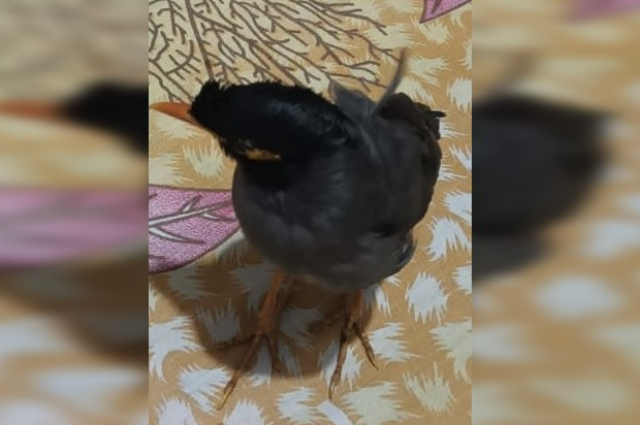
Photo credit: Saikat Kumar Basu
Introduction:
The trafficking of birds mimicking human speech is an alarming issue that poses a significant threat to both wildlife and biodiversity. These beautiful creatures, capable of imitating human voices, are highly sought after in the illegal wildlife trade. However, the consequences of this illicit practice extend far beyond the act itself, endangering bird populations, disrupting ecosystems, and contributing to the loss of biodiversity. This essay aims to shed light on the gravity of this issue and emphasizes the need for stringent measures to combat this form of wildlife crime.
The allure of talking birds:
Birds that can mimic human speech, such as parrots and mynah birds, possess a unique and captivating ability that captivates people's attention. Their capacity to mimic human voices and sounds makes them highly desired as exotic pets, status symbols, and even performers. Their enchanting mimicry often obscures the negative consequences of their illegal trade, leading to increased demand and further endangerment of these species.
Illegal wildlife trade and its impact:
The illegal trafficking of birds mimicking human speech fuels an expansive global trade network, generating substantial profits for criminal syndicates. This lucrative market creates incentives for poachers and traffickers to capture these birds from the wild, often using cruel and inhumane methods. Consequently, the populations of these species suffer severe declines, undermining ecological balance and jeopardizing the survival of entire bird species.
Ecological disruption:
Birds play a crucial role in maintaining ecosystem balance and biodiversity. They contribute to seed dispersal, pollination, insect control, and ecosystem dynamics. When populations of talking birds decline due to illegal trafficking, their absence can disrupt these ecological processes. Moreover, the removal of these birds from their natural habitats can lead to cascading effects on other species dependent on them, causing imbalances and potentially threatening the survival of other organisms within the ecosystem.
Conservation challenges:
Combating the illegal trafficking of birds mimicking human speech presents significant challenges for conservation efforts. The secretive nature of this trade, coupled with its international dimensions, makes it difficult to detect and prosecute those involved. Limited resources, corruption, and inadequate legal frameworks further impede the ability of authorities to curb this illegal practice effectively. Collaboration between governments, law enforcement agencies, and conservation organizations is crucial to address this issue comprehensively.

Photo credit: Saikat Kumar Basu
Ethical concerns and animal welfare:
The illegal trade in talking birds not only poses a threat to biodiversity but also raises ethical concerns and animal welfare issues. These intelligent creatures often endure stress, trauma, and mistreatment during the capture, transportation, and sale process. Inappropriate living conditions, lack of proper care, and the separation from their natural habitats negatively impact their physical and mental well-being. Recognizing the inherent value and rights of these birds is essential for ensuring their protection and welfare.
Sociology-economic and cultural pressures:
Mynahs (starlings) have several species and some of them can mimic a human voice. The mountain mynah, common mynah, jungle mynah, etc are some of them reported to be easily tamed by humans as pets and are capable of mimicry. Often young adults or sub-adults of different mynah species get accidentally separated from their caring parents and are harassed and attacked by common crows. Hence, they are forced to take refuge with humans for protection and for their survival. They are not tame but highly successful urbanized birds that live in close association with humans in both rural and urban areas. They are not shy of humans and are often found to live in close harmony with humans. Unfortunately, this very characteristic of the mynah species is making them vulnerable to illegal trade in trafficking. Previously, only the hill mynahs were targeted as they are the best-known species for mimicking human speech. But nowadays even, the young chicks and young adults of the common mynahs, jungle mynahs, pied mynahs, and even bank mynahs are being stolen or collected from their nests to feed to illegal wildlife trade of talking birds. Although none of the species are vulnerable, or endangered, and are mostly list concern species; however, the way they are being blooded and plundered from their nests it won’t take long to convert them into endangered species in the not-so-distant future. Education and awareness about biodiversity and strong legislation enforcement are essential to curb this evil trade. However, very little has been achieved at the ground level. Unless we take action, now, a multitude of human speech, and mimicry species, such as parrots, parakeets, mynahs (starlings), and lyre birds all are heading toward extinction.
Conclusion:
The illegal trafficking of birds mimicking human speech represents a grave threat to wildlife, biodiversity, and ethical considerations. Urgent action is necessary to combat this illicit trade and protect these remarkable creatures from exploitation and harm. Strengthening legislation, raising awareness, enhancing international cooperation, and supporting local communities in sustainable livelihoods are critical steps toward curbing this trade and safeguarding the future of these species. By addressing this issue proactively, we can strive to preserve our natural heritage and promote the welfare of all living beings sharing our planet.
